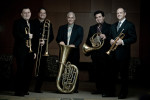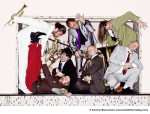Hushed reverence would best describe the accounts of Warren Deck’s performances with the New York Philharmonic; it was there he held sway from ’79 until 2001. The Houston Symphony, Rice University and Juilliard also felt the sway of Mr. Deck’s tuba, until his course led him out west to Denver in 2001. Warren Deck joins The Fourth Valve tm, as contributing editor Aaron Tindall makes his debut contributions as well. Join us as Deck reminds us that dreams come true…..Enjoy!
1. What was it like to be part of the recording Made in the USA and other projects with the Canadian Brass and members of the Boston Symphony Orchestra Brass and The New York Philharmonic Brass?
These projects were some of the most fun musical times I had. Getting to hang out with great players who were fun to be with whether we were playing or not was a particular joy. I had a sense during the recordings that these were special times. A couple of years ago, I was talking with Ronnie Romm and letting him know that those times together produced some of my fondest musical memories. He told me he felt the same way. I found it very gratifying that I was not alone in having that feeling.
2. Perhaps the inspiration for this project was the Antiphonal Music of Gabrieli with Brass from the Philadelphia Orchestra, Chicago Symphony and Cleveland Orchestra. What were/are your observations on that project and the influence that it had on your career?
Funny you should mention that recording as I literally burned out two LP’s of that recording from listening to it so much. I got my first one when I was in high school and was completely blown away. It got to the point where I could know which tuba player was playing after about two notes. The really cool thing about that recording (now that I have it on CD) is that 47 years later, I am still blown away by how well all of those people played. I would play along with that recording and knew it by rote and constantly used it as a reference recording whenever I got a new horn or mouthpiece. If I could play in tune with that recording, I felt safe in using the new equipment.
3. As you matured as a performer did the type/characteristics of the specific tuba you played on become more or less important?
They became more important. I view equipment like a shoe. A shoe you might want for playing basketball will be very different from a shoe you would want for climbing a mountain. While the equipment will never be a substitute for good skills, there is truth in having the right tool for the job. As you try for a broader range of musical expression, more and different types of toys can be quite helpful.
 4. What types of chamber music and solo skills were present in your orchestral playing? Have you ever thought of some colleagues in other Big Five orchestras incorporated more/less solo or chamber elements than what was needed?
4. What types of chamber music and solo skills were present in your orchestral playing? Have you ever thought of some colleagues in other Big Five orchestras incorporated more/less solo or chamber elements than what was needed?
The studio and practice room is where you learn to play your instrument well. I think chamber music teaches you to become a musician. The first step out of the studio is into chamber music where you begin to put your instrumental skills to work in the service of music. Unlike the studio, you now have to listen to something other than yourself while you are playing. You learn to adjust your playing to fit into sounds others make and at the same time find a way to contribute to the group sound. If your solo skills (your command of your instrument) are lacking, you might not be very good at fitting into a group because you are not as good a player as you need to be. By the same token, if your listening skills are lacking, you might not fit into the group stylistically and never know it because you don’t listen well.
These are all skills a good orchestral player needs. The geography is a lot more expanded because of the size of the group, but the same skills come to bear. The other element that comes into playing in an orchestra is that sometimes you need to lead something out, and sometimes you need to be right there with someone else who is appropriately leading something out. You need to know how to do both of these things and use your best judgement as to when to employ those skills. In order to do this you need to be able to listen out while you are playing.
5. Walk the reader through your definition of “style” when it comes to making the notes on the page come to “life”.
Getting a handle on style comes from detailed listening. How does the note begin? What is the shape and duration of the note? How does the note end? Is there any space between notes and if so, how much? How loud? What about shapes of phrases? How does it fit with time? Is it on the front, on the back, does it move up and back? What are the attributes of the sound?
I think it is helpful to look at as many elements of style as possible and expand those elements into as broad a range as you can. Making all of this into a listening game of how much can I notice lads to better ear. The other question to ponder is: What is the difference between real style and something that is just willy-nilly? There may never be a great answer to this question, but it is still worth pondering and the idea of recurring elements are what contribute my perception of something having style and therefore, life.
6. What inspirations were the most influential in informing your musicality?
As mentioned earlier, that Gabrieli recording with Philadelphia, Chicago and Cleveland was very influential. In addition, when I was in my junior year in college, our college orchestra went to the Canary Islands to play in an opera festival. I had no idea what that would be like, but the Canary Islands sounded like a fun place to spend 5 weeks. What could be bad about spending 5 weeks on a beach? Little did I know that a partial list of the singers included Joan Sutherland in Maria Stuarda and Birgit Nilsson singing Tosca. When I heard that at close range, it rocked my world. The degree to which these ladies brought it was beyond anything I had ever imagined. The other thing that floored me with them was their phrasing.
7. Which musicians (performers or conductors), have most made an impression on you and how/why?
Bernstein was truly a once in a lifetime type of musician. He had more heart and more intellect than anybody I ever came across.
I loved working with Zubin – a good heart and a great musician. He always made music making fun. He seemed to always revel in his players’ abilities, and allowed his players to enjoy the music making as well.
As for soloists, Pavarotti, Bronfman and Jesse Norman were always special when they came.
I think Phil Smith is the best player to ever sit in a principal trumpet chair and I got to enjoy him on a daily basis. I also got to hear Phil Myers on a daily basis and his fearlessness on the instrument led to truly great and unforgettable moments. Joe Alessi is an amazing trombone player and his consistency sure made life easy for me.
8. What three things do you most think about when performing/conducting?
What is the music here? What does it need? What is my function in the music here?
9. How did you decide to venture into arranging, and do you have any favorite composers or instruments?
I was asked by Phil Myers to arrange Candide for 8 horns for their upcoming recording with the American Horn Quartet. I had just been diagnosed with dystonia, my playing career was over and I think Phil was trying to be kind in giving me something to do. I attempted to get permission from the Bernstein estate for this and was denied. So that piece could be recorded but it can’t be legally played in public. I get requests for the music (even though it shouldn’t be publicly performed because of its difficulty) and I have to say no. I’ve done a few things for the Denver Brass, but I don’t think I’m very good at it and the Denver Brass has people who are much better at than I am. I respect any composer who can compose 8 bars, which is more than I can do, but I like the usual suspects that every low brass player likes – the ones who write good licks for us.
10. What differences in approaches have you noticed between different orchestras or brass sections with whom you have frequently performed?
I think I see more commonality among good brass sections than differences. Good ones all play in tune, in rhythm with good balance and a good blend. They all tend to be filled with good musicians. The great brass sections sweat the details and try to sound alike up and down the section. The differences are small, but real and listening for the stylistic elements noted above will begin to emerge. I think a lot of the differences are due to the acoustic environments these different sections find themselves in on a daily basis.
When I first got to the Philharmonic, I couldn’t believe how short they could play – and this is coming from a guy who grew up in the mid-west playing in bands. Then I played in Carnegie Hall, where most of those guys spent most of their careers and I understood why they could play so short. If you took what I thought of as a short note and put it in Carnegie, the hall turned it into something much longer. Of course this changed over time because the section moved the garbage dump known as Avery Fisher Hall and different adjustments were made.
My wife and I have a dream of going on a tour where we go to various cities and hear their orchestras play a good program in their own hall. Hopefully we’ll get to do that before we go completely deaf!
c. 2017 David William Brubeck All Rights Reserved www.davidbrubeck.com
MORE GREAT INTERVIEWS!
Jim Self
John Van Houten
Demondrae Thurman



 <
< 